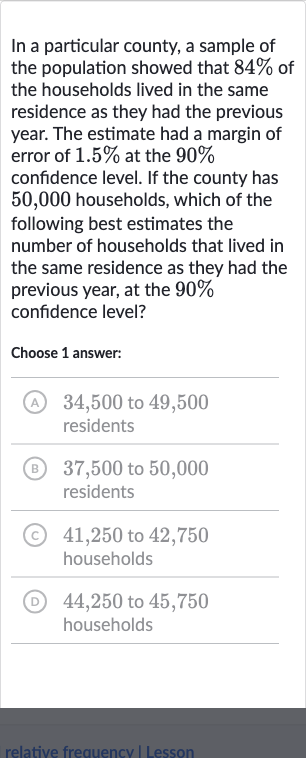AI tutor
Welcome to Bytelearn!
Let’s check out your problem:

In a particular county, a sample of the population showed that of the households lived in the same residence as they had the previous year. The estimate had a margin of error of at the confidence level. If the county has , households, which of the following best estimates the number of households that lived in the same residence as they had the previous year, at the confidence level?Choose answer:(A) , to , residents(B) , to , residents(C) , to , households(D) , to , households
Full solution
Q. In a particular county, a sample of the population showed that of the households lived in the same residence as they had the previous year. The estimate had a margin of error of at the confidence level. If the county has , households, which of the following best estimates the number of households that lived in the same residence as they had the previous year, at the confidence level?Choose answer:(A) , to , residents(B) , to , residents(C) , to , households(D) , to , households
- Calculate point estimate: Calculate the point estimate of the number of households that lived in the same residence as they had the previous year.Point estimate = Percentage Total number of households= \(0. ,\)=
- Calculate margin of error: Calculate the margin of error in terms of the number of households.Margin of error = Percentage margin of error Total number of households
- Determine lower bound: Determine the lower bound of the estimate at the % confidence level.Lower bound = Point estimate - Margin of error= =
- Determine upper bound: Determine the upper bound of the estimate at the % confidence level.Upper bound = Point estimate + Margin of error= =
- Identify correct answer: Identify the correct answer based on the calculated bounds.The correct answer is the range from the lower bound to the upper bound, which is to households.
More problems from A2-STA-013
QuestionGet tutor help
QuestionGet tutor help
QuestionGet tutor help
QuestionGet tutor help
QuestionGet tutor help
QuestionGet tutor help
QuestionGet tutor help
